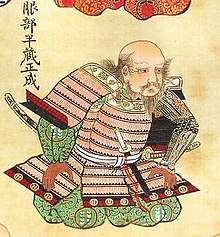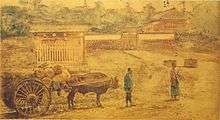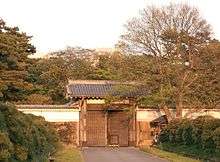Hattori Hanzō
Hattori Hanzō (服部 半蔵, ~1542[1] — December 23, 1596), also known as Hattori Masanari or Hattori Masashige (服部 正成) and nicknamed Oni no Hanzō (鬼の半蔵, Demon Hanzō),[2] was a famous Samurai of the Sengoku era, who served Tokugawa clan, credited with saving the life of Tokugawa Ieyasu and then helping him to become the ruler of united Japan.[3][4] He is often a subject of varied portrayal in modern popular culture.
Hattori Hanzō 服部 半蔵 | |
|---|---|
 | |
| Birth name | Hattori Masanari |
| Nickname(s) | "Demon Hanzō" |
| Born | c. 1542 Mikawa Province (now Iga-chō, Okazaki, Aichi) |
| Died | December 23, 1596 (aged 54) Edo, Musashi province |
| Allegiance | |
| Battles/wars | Attack on Udo castle Siege of Kaminogō Castle Siege of Kakegawa Battle of Anegawa Battle of Mikatagahara Battle of Nagashino Battle of Komaki and Nagakute Siege of Odawara |
Biography
Born the son of Hattori Hanzō Yasunaga (服部 半蔵(半三) 保長), a minor samurai in the service of the Matsudaira (later Tokugawa) clan.[5][2] He would later earn the nickname Oni no Hanzō (鬼の半蔵, Demon Hanzō)[2] because of the fearless tactics he displayed in his operations; this is to distinguish him from Watanabe Hanzo (Watanabe Moritsuna), who is nicknamed Yari no Hanzō (槍の半蔵, Spear Hanzō).[6]
Though Hanzō was born in Mikawa Province (now Iga-chō, Okazaki, Aichi), he often returned to Iga Province, home of the Hattori family. He fought his first battle, a night time attack on Udo Castle 1557, at the age of sixteen.[5][2]
Service under Ieyasu
Hanzo had a great contribution to Tokugawa Ieyasu's rise to power, helping the future Shogun bring down the Imagawa clan. After Imagawa Ujizane had held Ieyasu's wife and son as hostages in 1561, Hanzo made a successful hostage rescue of Tokugawa's family at Kaminogo castle in 1562; and went on to lay siege to Kakegawa castle in 1569. He served with distinction at the battles of Anegawa in 1570 and Mikatagahara in 1572.[5]
According to the Kansei Chōshū Shokafu, a genealogy of major samurai completed in 1812 by the Tokugawa shogunate, Hattori Hanzō rendered meritorious service during the Battle of Mikatagahara and became commander of an Iga unit consisting of one hundred fifty men. He captured a Takeda spy named Chikuan, and when Takeda's troops invaded Totomi, Hanzō counterattacked with only thirty men at the Tenryū River.
His most valuable contribution came in 1582 following Oda Nobunaga's death, when he led the future shōgun Tokugawa Ieyasu to safety in Mikawa Province across Iga territory with the help of remnants of the local Iga ji-samurai clans[2][7][8] as well as Kōga-ryū the neighboring local samurai families in the nearby Koka region.[9][10] According to some sources, Hanzō also helped in rescuing the captured family of Ieyasu.[11]
Hattori Hanzo served during the Odawara campaign and was awarded 8,000 koku. By the time Ieyasu entered Kantō, he was awarded an additional 8,000 koku and had 30 yoriki and 200 public officials for his services. Ieyasu was said to have also begun to employ more Iga ninja with Hanzō as their leader. Hanzō was known as an expert tactician and a master of sword fighting. Historical sources say he lived the last several years of his life as a monk under the name "Sainen" and built the temple Sainenji, which was named after him and mainly built to commemorate Tokugawa Ieyasu's elder son, Tokugawa Nobuyasu. Nobuyasu was accused of treason and conspiracy by Oda Nobunaga and was then ordered to commit seppuku by his father, Ieyasu. Hanzo was called in to act as the official second to end Nobuyasu's suffering, but he refused to take the sword on the blood of his own lord. Ieyasu valued his loyalty after hearing of Hanzo's ordeal and said, "Even a demon can shed tears."[12][13]
Hanzo's reputation as a ninja leader who commanded a 200-men strong unit of Iga warriors has grown to legendary proportions. He died at the age of 54 in 1596.[5]
Legacy


Tales of Hattori's exploits often attributed various supernatural abilities, such as teleportation, psychokinesis, and precognition,[2] and these attributions contribute to his continued prominence in popular culture.[5]
After his death on 4 November 1596, Hattori Hanzō was succeeded by his son, whose name was also Masanari, though written with different kanji. He was given the title of Iwami no Kami[14] and his Iga men would act as guards of Edo Castle, the headquarters of the government of united Japan. Hanzō is actually a name passed down through the leaders of the Hattori family meaning his father was also called Hanzō and so was his successor. Indeed, there are five people known as Hattori Hanzō throughout history[2]
To this day, artifacts of Hanzō's legacy remain. Tokyo Imperial Palace (formerly the shōgun's palace) still has a gate called Hanzō's Gate (Hanzōmon), and the Hanzōmon subway line which runs from Hanzōmon Station in central Tokyo to the southwestern suburbs is named after the gate, where his house was once located.[15][16][17] The neighborhood outside Hanzō's Gate is known as Wakaba, but before 1943 was named Iga-chō ("Iga Town").[18] Hanzō's remains now rest in the Sainen-ji temple cemetery in Yotsuya, Tokyo. The temple also holds his favorite spear and his ceremonial battle helmet. The spear, originally 14 feet (4.3 m) long and given to him by Ieyasu, was donated to the temple by Hanzō as a votive offering, but was damaged during the bombing of Tokyo in 1945.[19]
Hattori Hanzō makes frequent appearance in popular culture, both within Japan and abroad. In modern popular culture he is most often portrayed as involved with the Iga ninja clansmen.
See also
References
- According to various sources, he was born in 1541, 1542 or 1543.
- Joel Levy, Ninja: The Shadow Warrior (2008), p. 157-158
- Masaaki Hatsumi, Essence of Ninjutsu: The Nine Traditions (1988), p. 178
- Jason Glaser, Don Roley, Ninja (2006), p. 26
- Stephen Turnbull, Ninja AD 1460–1650 (2003), p. 12
- Stephen K. Hayes, The Mystic Arts of the Ninja (1985)
- Andrew Adams, Ninja: The Invisible Assassins (1970), p. 43
- Stephen Turnbull, Warriors of Medieval Japan (2007), p. 151
- Stephen K. Hayes, The Ninja and Their Secret Fighting Art (1990), p. 30
- Haha Lung, Ninja Shadowhand, The Art of Invisibility (2004), p. 50
- Hiromitsu Kuroi, More Secrets of the Ninja: Their Training, Tools and Techniques (2009), p. 94
- Thomas Louis, Tommy Ito, Samurai: The Code of the Warrior (2008), p. 112
- Arthur Lindsay Sadler, The Maker of Modern Japan: The Life of Tokugawa Ieyasu, C. E. Tuttle Co., 1978
- "Sengoku Era Ranks and Titles". Samurai-archives.com. Archived from the original on 2013-08-28. Retrieved 2013-07-07.
- Lisa Leventer, Fodor's Japan: The Complete Guide With the Best of Tokyo, Kyoto and Old Japan, Fodor's Travel Publications, 1996
- Fodor's Travel Publications, Fodor's Japan: Expert Advice and Smart Choices: Where to Stay, Eat, and Explore On and Off the Beaten Path (2000), p. 61
- Mikhail Vladimirovich Uspenskiĭ, Tatyana Mordkova, Natalia Smaznova, One Hundred Views of Edo: Woodblock Prints by Ando Hiroshige, Parkstone Press, 1997
- Matt Alt, Tokyo's really, really real ninja hideouts Archived 2012-11-02 at the Wayback Machine, CNNGo.com, 23 November 2011
- Stephen Turnbull, The Samurai Swordsman: Master of War (2008)